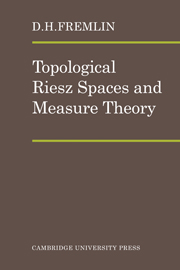7 - Representation of linear functionals
Published online by Cambridge University Press: 07 October 2011
Summary
Suppose that we are given a set X, a Riesz subspace E of Rx, and an increasing linear functional f : E → R. My object in this chapter is to discuss conditions under which f is an ‘integral’, that is, when there is a measure µ on X such that ∫ xdµ exists and is equal to fx for every x ∈ E. A necessary, and nearly sufficient, condition is that f should be ‘sequentially smooth’ [71B–71G]. Further conditions on f and E lead, of course, to stronger results [§§ 72, 73].
The outlines of the theory are not hard to appreciate. Unfortunately, the technical refinements needed for the strongest results are complex, and in their most general forms they are difficult to grasp intuitively. Each extra scrap of information costs us a good deal of hard work. I shall try to summarize the theory in a way which will show its essential structure and maintain reasonable simplicity in the theorems, though the proofs will inevitably be lengthy. The general approach of the first two sections of this chapter is close to that of toposøe T.M.
Sequentially smooth functionals
The first representation theorem I give [71G] is the most natural, in the sense that the hypotheses and consequences are most directly related here. In order not to have to repeat them in the next section, I remove certain parts of the argument into separate lemmas.
- Type
- Chapter
- Information
- Topological Riesz Spaces and Measure Theory , pp. 193 - 218Publisher: Cambridge University PressPrint publication year: 1974



